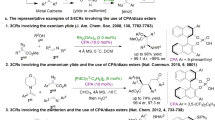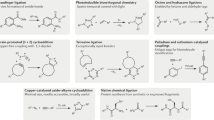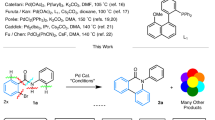Abstract
Girard and Sandulesco1 developed a method now known as the ‘Girard reaction’ for the isolation of small amounts of ketosteroids such as the sex hormones from natural products. Aldehydes and ketones in the mixture are converted into water-soluble hydrazone derivatives by treatment with the ‘Girard P’ or ‘T’ reagent, and the non-carbonyl compounds are removed by extraction with a non-polar solvent like ether. The ketone complexes are rapidly decomposed with mineral acid; but the aldehyde derivatives are claimed to be stable except in the presence of a large excess of acid and formaldehyde.
This is a preview of subscription content, access via your institution
Access options
Subscribe to this journal
Receive 51 print issues and online access
$199.00 per year
only $3.90 per issue
Buy this article
- Purchase on Springer Link
- Instant access to full article PDF
Prices may be subject to local taxes which are calculated during checkout
Similar content being viewed by others
References
Girard, A., and Sandulesco, G., Helv. Chim. Acta 19, 1095 (1936).
Lederer, E., and Nachmias, G., Bull. Soc. chim. France, 400 (1949).
Author information
Authors and Affiliations
Rights and permissions
About this article
Cite this article
FORSS, D., DUNSTONE, E. The Girard Reaction. Nature 173, 401–402 (1954). https://doi.org/10.1038/173401b0
Issue Date:
DOI: https://doi.org/10.1038/173401b0
Comments
By submitting a comment you agree to abide by our Terms and Community Guidelines. If you find something abusive or that does not comply with our terms or guidelines please flag it as inappropriate.



